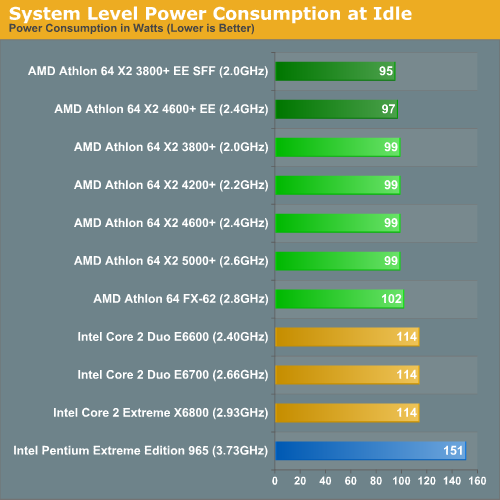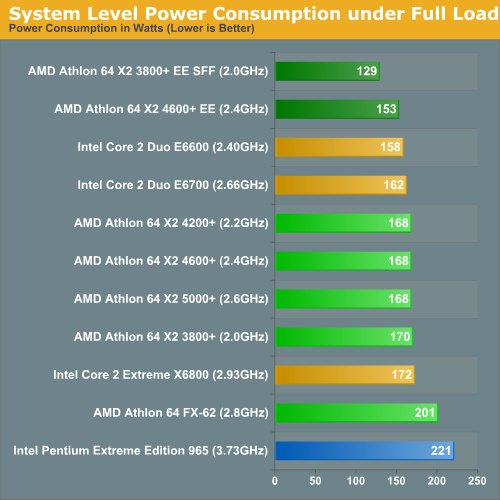Intel's Core 2 Extreme & Core 2 Duo: The Empire Strikes Back
by Anand Lal Shimpi on July 14, 2006 12:00 AM EST- Posted in
- CPUs
Power Consumption: Who is the king?
Intel promised us better performance per watt, lower energy consumed per instruction, and an overall serious reduction in power consumption with Conroe and its Core 2 line of processors. Compared to its NetBurst predecessors, the Core 2 lineup consumes significantly lower power - but what about compared to AMD?
This is one area that AMD is not standing still in, and just days before Intel's launch AMD managed to get us a couple of its long awaited Energy Efficient Athlon 64 X2 processors that are manufactured to target much lower TDPs than its other X2 processors. AMD sent us its Athlon 64 X2 4600+ Energy Efficient processor which carries a 65W TDP compared to 89W for the regular 4600+. The more interesting CPU is its Athlon 64 X2 3800+ Energy Efficient Small Form Factor CPU, which features an extremely low 35W rating. We've also included the 89W Athlon 64 X2s in this comparison, as well as the 125W Athlon 64 FX-62.
Cool 'n Quiet and EIST were enabled for AMD and Intel platforms respectively; power consumption was measured at the wall outlet. We used an ASUS M2NPV-VM for our AM2 platform and ASUS' P5W DH Deluxe for our Core 2 platform, but remember that power consumption will be higher with a SLI chipset on either platform. We used a single GeForce 7900 GTX, but since our power consumption tests were all done at the Windows desktop 3D performance/power consumption never came into play.
We took two power measurements: peak at idle and peak under load while performing our Windows Media Encoder 9 test.

Taking into consideration the fact that we were unable to compare two more similar chipsets (we will take a look back at that once retail Intel nForce 5 products hit the shelves), these power numbers heavily favor Intel. The releative power savings over the Extreme Edition 965 show just how big the jump is, and the ~15% idle power advantage our lower power AMD motherboard has over the Intel solution isn't a huge issue, especially when considering the performance advantage for the realtively small power investment.

When looking at load power, we can very clearly see that AMD is no longer the performance per watt king. While the Energy Efficient (EE) line of X2 processors is clearly very good at dropping load power (especially in the case of the 3800+), not even these chips can compete with the efficiency of the Core 2 line while encoding with WME9. The bottom line is that Intel just gets it done faster while pulling fewer watts (e.g. Performance/Watt on the X6800 is 0.3575 vs. 0.2757 on the X2 3800+ EE SFF).
In fact, in a complete turn around from what we've seen in the past, the highest end Core 2 processor is actually the most efficient (performance per Watt) processor in the lineup for WME9. This time, those who take the plunge on a high priced processor will not be stuck with brute force and a huge electric bill.










202 Comments
View All Comments
Josh7289 - Friday, July 14, 2006 - link
When I go to college next year, I know what I'll be buying. :)Pirks - Friday, July 14, 2006 - link
When I see AMD price cuts next month, I know what your face'll look like. :)theoryzero - Friday, July 14, 2006 - link
This review (and the many others from other review sites) is interesting in that it confirms Intel's bold claims made back in March.However, with that out of the way, what I really want to know is which chipset/MoBo to go with? Is springing for high-end memory worth it on Core2? Any plans for a motherboard review in the very near future? Given the Abit AB9 preview and recent articles on DDR2-1000 memory I kind of expected this stuff to show up after the NDA was lifted too.
Wesley Fink - Friday, July 14, 2006 - link
Conroe starts shipping July 27th - the original launch date. Intel moved the launch date back two weeks because OEMs like Dell and HP were hot to start advertising and shipping Conroe systems. I suspect Intel was also trying to salvage their NDA. Good news is hard to contain and two more weeks of NDA would have likely resulted in more info leaks that Intel did not want to turn into a flood.You will be able to find answers at AnandTech to your basic Conroe motherboard and memory questions early next week.
theoryzero - Friday, July 14, 2006 - link
Sounds good, thanks!bob661 - Friday, July 14, 2006 - link
Thanks.Howard - Friday, July 14, 2006 - link
I would have loved to see minimum FPS as well as average FPS. The review was great otherwise.JarredWalton - Friday, July 14, 2006 - link
While we could report those scores, we didn't feel we should at least on Oblivion. The reason for that is because the Oblivion runs were manually tested with FRAPS, and the results aren't perfectly comparable between runs. Anyway, here are some of the numbers, but recognize that the margin of error is going to be larger than what you would see with automated timedemos:Oblivion Bruma:
Core E6300: 32-53.7-77
Core X6800: 47-78.6-117
AMD 3800+: 27-47.0-72
AMD FX-62: 38-62.5-94
Oblivion Dungeon:
Core E6300: 39-81.3-211
Core X6800: 57-106.5-214
AMD 3800+: 35-72.0-189
AMD FX-62: 46-89.9-211
F.E.A.R.:
Core E6300: 34-92-224
Core X6800: 41-118-310
AMD 3800+: 28-83-212
AMD FX-62: 38-101-247
Rise of Legends:
Core E6300: 8-68.2-137
Core X6800: 45-120.5-216
AMD 3800+: 5-52.1-115
AMD FX-62: 25-78.4-144
Minimum frame rates in the Rise of Legends benchmark are zero on most of the Pentium D systems, so again we take those with something of a grain of salt. Regardless of how you look at it, though, the Core 2 Duo processors consistently outperform their AMD equivalents in gaming results. We will be looking at additional games next week in our motherboard reviews.
nowuadmit - Friday, July 14, 2006 - link
First off, when u guys reviewed a 486/33 for the first time... it was also "the fastest piece of silicon the world has ever seen"... then later, when u saw the P2-550... THAT was the "fastest piece of silicon... blah blah".Well its nice that intel has made a really expensive and barely available new chip, so they can finally match (or even exceed by a few points) AMD's reasonably priced previous generation. So now u can say they have the fastest, and if u want to spend thousands on a CPU that is only slightly faster than something that costs hundreds of dollars, HEY BE MY GUEST! there have been worse wastes of money! (in theory anyways, since the avg american wont be able to actually find any of these in the local stores for quite some time, if intel follows their previous habits).
Anyhow the point of my comment... i think this is a good thing. i mean, anything that actually causes an intel fanboi to admit finally that intel has been reaming your butts for 5 years..
while the people who simply buy whatever CPU makes the most sense have been enjoying getting great quality nookie from AMD! SO i present to you, this Technical Quote of the Year, spoken on behalf of all intel fanbois with half a brain!
Technical Quote of the Year:
"...power hungry, poor performing, non-competitive garbage (sorry guys, it's the truth) that Intel has been shoving down our throats for the greater part of the past 5 years."
Congradulations on your honesty, finally.
MrKaz - Friday, July 14, 2006 - link
Yes that’s truth.80% of Intel crap, only 20% is good. The Pentium M.
So they say 5 years ago until now Intel was “all” crap. I think Northwood was/is very good.
My maximum price is 100$ (or 120$ with cooler) for a CPU. Only AMD as an honest performing CPU for those prices.